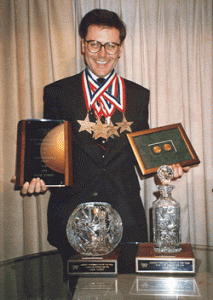10 Steps of Marketing With No Money; Then Sell Out
![]() In the late 80’s Your Business Blogger was part of a medical device start-up. With no money.
In the late 80’s Your Business Blogger was part of a medical device start-up. With no money.
We were launching new products, with new technology, teaching new surgical techniques, new medicine.
Conventional wisdom dictated hiring a half-dozen advanced-skill nurses to teach around the country. Our Board of Directors said no budget. This was a problem. Our product required extensive inservice training.
With a product that was 100 times the cost of its nearest competitive substitute.
So what’s a thinly capitalized company in trouble to do?
1) Throw a party.
My boss, John Harper, came up with the solution. Conduct training seminars. If we can’t go to the clinician; bring the clinician to us. (John Harper said something about mountains and Mohammed.) We would outsource the training to temping Nurse Consultants. We expanded his idea making the classes into events. Food, flowers, contests, framed certificates, lapel pins. More fun than a TupperWare party. Avon calling. Our mostly female nurses loved it.
…this list
of 10 steps provides a case study
of brilliance in hindsight after the fact.
And desperation and frustrationbefore the fact…
This list of 10 steps provides a case study. Of brilliance in hindsight after the fact. And desperation and frustration before the fact.
2) Independent Contractors. Identify, recruit, train and motivate per diem consultants. 1099 not W-2. No fixed costs. Easy to hire. Easy to fire. I could make a lot of mistakes. And did.
3) Advertising. Small ad in local trade journals — ad buy was for multiple exposures,
not size. Limited ad budget turned out to force creative thinking. I also learned that
these thought and opinion leaders also were contributors to text books —
and were looking for the latest technology — and wrote new chapters on advanced
clinical techniques featuring our products.
4) Talent. Hired thought and opinion leaders who happened to be users. I simply hired my current customers. In setting up seminars the customers conducted the classes. Our instructors were typically ‘nurse of the year’ award winners for their organizations with advanced practice suffixes. These were smart women and everyone knew it. I hired 24 of the best.
5) Invitations. Snail-mailed and faxed personally-addressed invitations to thought and opinion leaders who were not customers. And phone calls. To attend our training seminars. A fax machine was hi-tech at the time. Hi-tech. Hi-touch. A personal invitation always sells.
6) Partners. Linked with local chapters of professional nurse organizations. Who were our key influencers and decision makers. Attended every industry trade show possible — I was less interested in the attendees as in the booth space buyers next to me — who were my channels of distribution.
7) Segment. Smallest, targeted market segment. We thought we would be selling to the 6,000 hospitals across the country. Nope. Not yet. It was the new home health care market. Which also was demanding performance over price. This tiny market segment was less price sensitive than hospitals.
8) Love. Appreciate the customer. Whenever a nurse passed (inserted) one of our catheters, I awarded her the coveted Landmark Nurse lapel pin. And a large framed certificate signed by the bosses. And corsages. Coming to our seminars was like going to the prom. I really loved my nurses. Still do.
9) Heeeeeree’s Johnny. Your Business Blogger(R) acted as the Master of Ceremonies introducing the instructor and guided the logistics. There was no sales pitch. I openly disclosed that the Nurse Consultant was an instructor on the payroll. (At $500 a class — a lot of money at the time. Goodness, a lot of money anytime.) This Full Disclosure had an unanticipated consequence: Every nurse attending wanted to teach part time and would approach me later to get in on the $500 per gig action. Who knew?
10) Visit. Follow-up with a face-to-face visit. So here was my pitch: Buy the frightfully expensive product, I’ll train you, bring you roses, guarantee your happiness and patient outcomes. Or your money back.
So.
The seminars were conducted at a fraction of the cost of hiring a team of clinicians full time. And we were able to bury the expense under the travel & entertainment budget. Which, as it happens, the seminars were. delectare et docere
So what?
I collected baubles for sales numbers.
And then what?
The company was sold to Johnson & Johnson. A profitable experience for the investors and stock holders.
Need to market with no money?
Throw a party.
Was this helpful? Do comment.
Consider a free eMail subscription for this site.
Thank you (foot)notes:
I had some terrific bosses at Menlo Care, Inc.: John Harper, Dave Maupin, Chuck Schreiber.
Read more on Menlo Care, Inc. after the jump.
Basil’s Blog has good content and links.
Menlo Care, Inc. (Nasdaq: JNJ)
Menlo Care is a company with materials, science, and manufacturing know-how transferred from Raychem Corporation, started in 1985 to develop “low trauma,” high-performance catheters that are less harmful to patients’ veins and can be left in place for longer periods of time. Menlo Care was acquired by Johnson & Johnson in 1995.


hehe i love the idea
now do you have a clue as to how i can market my website http://www.warstoke.com and make it turn a profit
with out violating my host no spam policy
anyways i dont think spam works i dont open it
I like the ideas but what about when you have a negitive budget. and your trying to basicly start making money from just a website an idea and several nights of insomnia
oh and its good to see a conservitive voice on the internet.
90% of what i find is bush bashing and reagan hating
These are great techniques. We have not used many of them to recruit our practitioners. However, I believe we will start using them during our next quarter sales focus.
-Randy
http://www.4mysales.com
The Carnival Comes Down Under – Carnvival of Entrepreneurship #3
Roll up, roll up !! Welcome to the 3rd edition of the Carnival of Entrepreneurship. The carnival has travelled far over the past week. From Anita Campbell’s stella hosting last week it has moved westward across the USA, crossed
10 Steps to Marketing With No Money
Jack Yoest:
In the late 80’s Your Business Blogger was part of a medical device start-up. With no money.
We were launching new products, with new technology, teaching new surgical techniques, new medicine.
Conventional wisdom dictated hiring …
i agree with warstroke, how do you promote a website with no money. the thing is i have a special where any business can add their business to my website free, and NO ONE is taking advantage of it.
Where did you get money to pay the costs? Or have I missed something?
ISO is a non-governmental organization established in 1947 in Geneva, Switzerland. Today, ISO has more than one hundred member countries. The mission of ISO is to promote the development of standardization and related activities in the global marketplace, to simplify the international exchange of goods and services, and to develop cooperation in the spheres of intellectual, scientific, technological and economic activities.